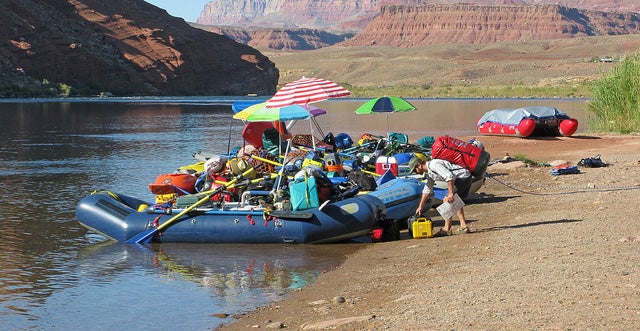
For the contiguous United States, the first
nine months of 2012 were the, according to the National Oceanic and Atmospheric Administration. As of October 2, 64 percent
of the United States was in the middle of a drought. Wyoming and Colorado experienced the
warmest summer on record, while Wyoming and Nevada saw the . In western and central regions of the
country, wildfires burned a record-breaking 3.6 million acres in August.
In other words, it was a cruel summer. It stressed wildlife
and depleted water reserves, but it also made life difficult for river runners
in the Mountain West, whose business success is dictated largely by the health
of the rivers they run. This followed very big water during the summer of 2011,
thanks to major snowfall during the 2010-2011 season.
“We're usually kayaking in March, April, May, and
usually into June,” said Peter Van De Carr, who operates
in Steamboat Springs and runs the Yampa River. “But last summer, we were
done [kayaking] at the end of March. As of June 20, the river was 40 cubic feet per second and going down. A year before, June 20, 2011, it was 4,000cfs and going up.”
“Some would say it's not climate change, but climate
strange, with one of the wettest years on record followed by one of the
driest,” said Soren Jespersen, northwest Colorado wildlands coordinator
for the Wilderness Society. “I think all the businesses that depend
somewhat on consistent weather patterns are having a hard time adjusting to
these shifts, whether it be ski resorts or river guides.”
In addition to low water issues, add fear over wildfires and suddenly
keeping a guiding business afloat becomes even harder. When I asked fellow
Coloradan Bill Dvorak how this past summer affected his efforts to keep his
rafts full on the Arkansas River, where he operates ,
he didn't pull any punches. “One thing that affects it is the spin that people
like you put on these stories,” he said, referencing news coverage of
wildfires that he feels paints too broad a stroke and often infers that
wildfires impact a larger area that they actually do.
“The average consumer is poorly educated when it comes
to geography,” Dvorak added. They hear about a fire and they think it is
impacting a larger area than it is, he says, noting that while the Waldo Fire
raged near Colorado Springs, around 100 miles away, his phone was not ringing
much except for people calling to make cancellations.
ADAPTATION
Both Van De Carr and Dvorak agree that climate change is
real and is making it more difficult to operate their businesses. “Big
water followed by droughtÔÇöthose events are going to intensify, and I believe in
climate change,” Dvorak said. Low water “shut us down completely
several times this year,” said Van De Carr.
Outfitters are using a range of approaches to react to these
erratic conditions in their respective home offices, so to speak. Dvorak, for example, uses boats that are sized appropriately for water levels and is
fortunate in that there are some
over water levels in the Arkansas River. “I don't run spring rivers [fed by snowpack]
anymore,” Dvorak said. “They are just so unpredictable, it's harder
to run those.”
But because the Yampa River, which is Van De Carr's home
base, does not have any major water level controls (via diversions or dams),
various stakeholders have begun working together to manage the river and reduce
negative impacts. “We are especially vulnerable to climate changeÔÇöor
drought, or whatever you want to call itÔÇöbecause we are so dependent on the
river's natural hydrograph. When it is much bigger or smaller, everything has
to change,” Van De Carr said.
During hot summers with low water levels and in years with
low precipitation, fish are generally stressed by increased water temperatures
and reduced food sources. Paddling and fishing rivers when they are in this
vulnerable state only exacerbates these stresses on fish, as do water
withdrawals used for agriculture. The community of Steamboat Springs, Colorado,
through which the Yampa flows, has set limits on river use that are aimed at
reducing recreational impacts. “We came to this set of rules
collectively,” Van De Carr said. “If the river is under 85cfs, we
don't run it.”
This past summer, this meant that he was forced to lay off
his employees after the river flowed below this limit for a number of days, and
then he had to scramble to find replacement employees once mid-summer rains made the river
runnable again. Still, he says the community's efforts to adapt to the low
water ultimately helped him.
These efforts included farmers and ranchers who limited
their take of the river for irrigation. It also included, Van De Carr said, an
“unprecedented” contribution from the Colorado Water Trust, which
worked with local water agencies to acquire water from a nearby reservoir in
order to boost flow. “It purchased 4,000 acre feet of water, through a
$140,000 contribution,” he explained.
This marks an important evolution in using Colorado's water
laws. Historically, Van De Carr said, “it's been a consumptive world”
in which water resources are removed. That's starting to change as
municipalities begin realizing how important it is to have healthy rivers, not
just to support agriculture and industry but also to support recreation and
tourism.
But Soren Jespersen believes these efforts are not enough on
their own. “Adaptation is one tool but unfortunately, climate change is
going to move faster than weÔÇÖre moving on these solutions,” he said. “We need to get to
the source of the problem, and that source is much bigger than a drought or
flood. Americans have a long history of putting our minds to something and
getting it done, but when it comes to our dependence on oil and gas, we're
failing.”
ÔÇöMary Catherine O'Connor